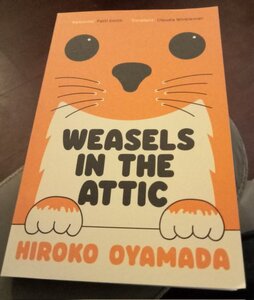2025 has begun, and we are starting the year in Japan. This is the first book by Maki Kashimada to appear in English translation, and it collects together two novellas. I would say the main theme connecting them is family, with contrasting relationships in each.
In the novella ‘Touring the Land of the Dead’, we meet Natsuko, whose family once lived the high life, but now her mother and brother are content to scrounge off her. She is caught between them and her husband Tachi, who is unable to do much for himself due to the effects of a neurological disease.
Natsuko books a break for herself and Tachi at a health retreat which used to be a luxury hotel that her family would visit. Those old times are captured on 8 mm film that feels like a distant world to our protagonist:
Her mother’s brother, watching the dance from a leather sofa, was brazenly holding a champagne glass. And her mother herself, wanting to take a sip, was trying to snatch it away. There was something impenetrably startling about their actions, but in the middle of that monochrome world they flowed silently, matter-of-factly.
Translation from Japanese by Haydn Trowell
Being at the retreat, moving through the same spaces as her relatives once did, sparks off visions of the past in Natsuko. Their effect is disconcerting:
Her young mother, thinking that she was special. Thinking that she was one of the chosen few. Natsuko is overcome with vertigo, her heart filled with disgust. Just as it was all beginning to become too unbearable, a round rubber ring cut across her vision.
That rubber ring is the tyre of Tachi’s wheelchair, a reminder of practical concerns in the present. This trip and the memories stirred allow Natsuko to confront how she views her birth family, and to move beyond this. They also allow her to appreciate where Tachi is coming from. She has always wondered why he doesn’t complain about what happens to him, but now she can see that he’s choosing to get on with life. The closing sense is that Natsuko now has the means to do the same.
If the protagonist of Kashimada’s first novella is pulling away from her family, the narrator of the second, ‘Ninety-Nine Kisses’, remains close to hers – sometimes uncomfortably so. Nanako illustrates her feelings towards her three sisters:
I’m just completely taken by my sisters, my sisters who don’t let themselves get overwhelmed by such things, who are able to go on fighting fearlessly among themselves over the same man. They’re my whole standard of reference. My personality only serves to add something to theirs. It might not even add anything. I’m just an echo of them. But it’s an erotic experience, this way of being.
The sisters’ closeness is challenged by the arrival of a man in their lives – as is Nanako’s sense of herself and her place. An acute confrontation with emotions is common to both of the novellas in Kashimada’s volume, and the aftermath lingers in the mind.
Touring the Land of the Dead is published by Europa Editions UK.
This review is for January in Japan, which Tony is hosting at Tony’s Reading List.






 Seventeen-year-old Mari is working at her mother’s hotel when a middle-aged man and a prostitute are thrown out for rowing and disturbing the other guests. Mari is drawn to the man, and starts to see him regularly; he tells her that he’s a Russian translator – the heroine of the novel he’s working on is even named Marie. The two enter into an intimate, masochistic relationship – which, naturally enough, can’t last forever.
Seventeen-year-old Mari is working at her mother’s hotel when a middle-aged man and a prostitute are thrown out for rowing and disturbing the other guests. Mari is drawn to the man, and starts to see him regularly; he tells her that he’s a Russian translator – the heroine of the novel he’s working on is even named Marie. The two enter into an intimate, masochistic relationship – which, naturally enough, can’t last forever. The latest title in the
The latest title in the  I couldn’t take part in a theme month like
I couldn’t take part in a theme month like  Kawashima Masayuki, the protagonist of Ryu Murakami’s Piercing (translated by Ralph McCarthy), stands over his baby daughter’s crib with an ice pick, testing his resolve not to use it. The full darkness beneath Kawashima’s outwardly happy family life is soon revealed, as we learn that he once stabbed a woman with an ice pick, and he’s afraid he’ll do so again to the baby. He convinces himself that the only way to deal with these feelings is to stab a stranger instead. So he checks into a hotel, calls for a prostitute, and waits.
Kawashima Masayuki, the protagonist of Ryu Murakami’s Piercing (translated by Ralph McCarthy), stands over his baby daughter’s crib with an ice pick, testing his resolve not to use it. The full darkness beneath Kawashima’s outwardly happy family life is soon revealed, as we learn that he once stabbed a woman with an ice pick, and he’s afraid he’ll do so again to the baby. He convinces himself that the only way to deal with these feelings is to stab a stranger instead. So he checks into a hotel, calls for a prostitute, and waits. Where Piercing is short and tight, Natsuo Kirino’s Out (translated by Stephen Snyder) is long and (relatively) roomy, but it shares a focus on individuals at extremes of behaviour. Four women work nights on the production lines of a boxed-lunch factory. In the heat of the moment, one kills her husband, driven to her wit’s end by his abuse. One of her colleagues, Masako Katori, takes charge of disposing of the body, gradually drawing the other women into the secret. Then the pressure is on to keep the killing hidden, from the police and other prying eyes.
Where Piercing is short and tight, Natsuo Kirino’s Out (translated by Stephen Snyder) is long and (relatively) roomy, but it shares a focus on individuals at extremes of behaviour. Four women work nights on the production lines of a boxed-lunch factory. In the heat of the moment, one kills her husband, driven to her wit’s end by his abuse. One of her colleagues, Masako Katori, takes charge of disposing of the body, gradually drawing the other women into the secret. Then the pressure is on to keep the killing hidden, from the police and other prying eyes.
Recent Comments